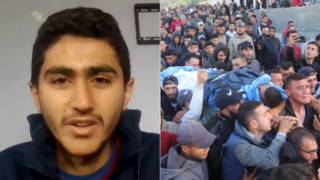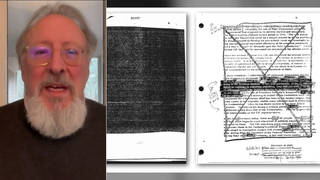
By Amy Goodman and David Goodman
In our new book, The Exception To the Rulers: Exposing Oily Politicians, War Profiteers and the Media That Love Them, we titled one chapter “The Lies of Our Times” to examine how The New York Times coverage on Iraq and its alleged stockpiles of weapons of mass destruction helped lead the country to war. Today, The New York Times, for the first time, raised questions about its own coverage in an 1,100-word editor’s note. Here is an excerpt from our section of the book on the New York Times and Iraq.
“From a marketing point of view, you don’t introduce new products in August.”
— Andrew H. Card, White House Chief of Staff
speaking about the Iraq war P.R. campaign, September 6, 2002
In the midst of the buildup to war, a major scandal was unfolding at The New York Times-the paper that sets the news agenda for other media. The Times admitted that for several years a 27-year-old reporter named Jayson Blair had been conning his editors and falsifying stories. He had pretended to be places he hadn’t been, fabricated quotes, and just plain lied in order to tell a sensational tale. For this, Blair was fired. But The Times went further: It ran a 7,000-word, five-page expose on the young reporter, laying bare his personal and professional escapades.
The Times said it had reached a low point in its 152-year history. I agreed. But not because of the Jayson Blair affair. It was The Times coverage of the Bush-Blair affair.
When George W. Bush and Tony Blair made their fraudulent case to attack Iraq, The Times, along with most corporate media outlets in the United States, became cheerleaders for the war. And while Jayson Blair was being crucified for his journalistic sins, veteran Times national security correspondent and best-selling author Judith Miller was filling The _Times_’ front pages with unchallenged government propaganda. Unlike Blair’s deceptions, Miller’s lies provided the pretext for war. Her lies cost lives.
If only The New York Times had done the same kind of investigation of Miller’s reports as it had with Jayson Blair.
The White House propaganda blitz was launched on September 7, 2002, at a Camp David press conference. British Prime Minister Tony Blair stood side by side with his co-conspirator, President George W. Bush. Together, they declared that evidence from a report published by the UN International Atomic Energy Agency (IAEA) showed that Iraq was “six months away” from building nuclear weapons.
“I don’t know what more evidence we need,” crowed Bush.
Actually, any evidence would help-there was no such IAEA report. But at the time, few mainstream American journalists questioned the leaders’ outright lies. Instead, the following day, “evidence” popped up in the Sunday New York Times under the twin byline of Michael Gordon and Judith Miller. “More than a decade after Saddam Hussein agreed to give up weapons of mass destruction,” they stated with authority, “Iraq has stepped up its quest for nuclear weapons and has embarked on a worldwide hunt for materials to make an atomic bomb, Bush administration officials said today.”
In a revealing example of how the story amplified administration spin, the authors included the phrase soon to be repeated by President Bush and all his top officials: “The first sign of a 'smoking gun,' [administration officials] argue, may be a mushroom cloud.”
Harper’s publisher John R. MacArthur, author of Second Front: Censorship and Propaganda in the Gulf War, knew what to make of this front-page bombshell. “In a disgraceful piece of stenography,” he wrote, Gordon and Miller “inflated an administration leak into something resembling imminent Armageddon.”
The Bush administration knew just what to do with the story they had fed to Gordon and Miller. The day The Times story ran, Vice President Dick Cheney made the rounds on the Sunday talk shows to advance the administration’s bogus claims. On NBC’s Meet the Press, Cheney declared that Iraq had purchased aluminum tubes to make enriched uranium. It didn’t matter that the IAEA refuted the charge both before and after it was made. But Cheney didn’t want viewers just to take his word for it. “There’s a story in The New York Times this morning,” he said smugly. “And I want to attribute The Times.”
This was the classic disinformation two-step: the White House leaks a lie to The Times, the newspaper publishes it as a startling expose, and then the White House conveniently masquerades behind the credibility of The Times.
“What mattered,” wrote MacArthur, “was the unencumbered rollout of a commercial for war.”4
Judith Miller was just getting warmed up. Reporting for America’s most influential newspaper, Miller continued to trumpet administration leaks and other bogus sources as the basis for eye-popping stories that backed the administration’s false premises for war. “If reporters who live by their sources were obliged to die by their sources,” Jack Shafer wrote later in Slate, “Miller would be stinking up her family tomb right now.”
After the war, Shafer pointed out, “None of the sensational allegations about chemical, biological, or nuclear weapons given to Miller have panned out, despite the furious crisscrossing of Iraq by U.S. weapons hunters.”
Did The New York Times publish corrections? Clarifications? Did heads roll? Not a chance: Judith Miller’s “scoops” continued to be proudly run on the front pages.
Here are just some of the corrections The Times should have run after the year-long campaign of front-page false claims by one of its premier reporters, Judith Miller.
FROM THE NEW YORK TIMES DEPARTMENT OF CORRECTIONS
Scoop: “U.S. Says Hussein Intensifies Quest for A-Bomb Parts,” by Judith Miller and Michael R. Gordon, September 8, 2002. The authors quote Ahmed al-Shemri (a pseudonym), who contends that he worked in Iraq’s chemical weapons program before defecting in 2000. ” 'All of Iraq is one large storage facility,' said Mr. Shemri, who claimed to have worked for many years at the Muthanna State Enterprise, once Iraq’s chemical weapons plant.” The authors quote Shemri as stating that Iraq is stockpiling “12,500 gallons of anthrax, 2,500 gallons of gas gangrene, 1,250 gallons of aflatoxin, and 2,000 gallons of botulinum throughout the country.”
Oops: As UN weapons inspectors had earlier stated-and U.S. weapons inspectors confirmed in September 2003-none of these claims were true. The unnamed source is one of many Iraqi defectors who made sensational false claims that were championed by Miller and The Times.
Scoop: “White House Lists Iraq Steps to Build Banned Weapons,” by Judith Miller and Michael Gordon, September 13, 2002. The article quotes the White House contention that Iraq was trying to purchase aluminum pipes to assist its nuclear weapons program.
Oops: Rather than run a major story on how the United States had falsely cited the UN to back its claim that Iraq was expanding its nuclear weapons program, Miller and Gordon repeated and embellished the lie.
Contrast this with the lead paragraph of a story that ran in the British daily The Guardian on September 9: “The International Atomic Energy Agency has no evidence that Iraq is developing nuclear weapons at a former site previously destroyed by UN inspectors, despite claims made over the weekend by Tony Blair, western diplomatic sources told The Guardian yesterday.” The story goes on to say that the IAEA “issued a statement insisting it had 'no new information' on Iraq’s nuclear program since December 1998 when its inspectors left Iraq.”
Miller’s trumped-up story contributed to the climate of the time and The Times. A month later, numerous congressional representatives cited the nuclear threat as a reason for voting to authorize war.
Scoop: “U.S. Faulted Over Its Efforts to Unite Iraqi Dissidents,” by Judith Miller, October 2, 2002. Quoting Ahmed Chalabi and Defense Department adviser Richard Perle, this story stated: “The INC [Iraqi National Congress] has been without question the single most important source of intelligence about Saddam Hussein.”
Miller airs the INC’s chief complaint: “Iraqi dissidents and administration officials complain that [the State Department and CIA] have also tried to cast doubt on information provided by defectors Mr. Chalabi’s organization has brought out of Iraq.”
Oops: Miller championed the cause of Chalabi, the Iraqi exile leader who had been lobbying Washington for over a decade to support the overthrow of Saddam Hussein’s regime. As The Washington Post revealed, Miller wrote to Times veteran foreign correspondent John Burns, who was working in Baghdad at the time, that Chalabi “has provided most of the front page exclusives on WMD [weapons of mass destruction] to our paper.”
Times readers might be interested to learn the details of how Ahmed Chalabi was bought and paid for by the CIA. Chalabi heads the INC, an organization of Iraqi exiles created by the CIA in 1992 with the help of the Rendon Group, a powerful public relations firm that has worked extensively for the two Bush administrations. Between 1992 and 1996, the CIA covertly funneled $12 million to Chalabi’s INC. In 1998, the Clinton administration gave Chalabi control of another $98 million of U.S. taxpayer money. Chalabi’s credibility has always been questionable: He was convicted in absentia in Jordan of stealing some $500 million from a bank he established, leaving shareholders high and dry. He has been accused by Iraqi exiles of pocketing at least $4 million of CIA funds.
In the lead-up to war, the CIA dismissed Chalabi as unreliable. But he was the darling of Pentagon hawks, putting an Iraqi face on their warmongering. So the Pentagon established a new entity, the Office of Special Plans, to champion the views of discredited INC defectors who helped make its case for war.
As Howard Kurtz later asked in The Washington Post: “Could Chalabi have been using The Times to build a drumbeat that Iraq was hiding weapons of mass destruction?”
Scoop: “C.I.A. Hunts Iraq Tie to Soviet Smallpox,” by Judith Miller, December 3, 2002. The story claims that “Iraq obtained a particularly virulent strain of smallpox from a Russian scientist.” The story adds later: “The information came to the American government from an informant whose identity has not been disclosed.”
Smallpox was cited by President Bush as one of the “weapons of mass destruction” possessed by Iraq that justified a dangerous national inoculation program-and an invasion.
Oops: After a three-month search of Iraq, ” 'Team Pox' turned up only signs to the contrary: disabled equipment that had been rendered harmless by UN inspectors, Iraqi scientists deemed credible who gave no indication they had worked with smallpox, and a laboratory thought to be back in use that was covered in cobwebs,” reported the Associated Press in September 2003.
Scoop: “Illicit Arms Kept Till Eve of War, an Iraqi Scientist Is Said to Assert,” by Judith Miller, April 21, 2003. In this front-page article, Miller quotes an American military officer who passes on the assertions of “a man who said he was an Iraqi scientist” in U.S. custody. The “scientist” claims that Iraq destroyed its WMD stockpile days before the war began, that the regime had transferred banned weapons to Syria, and that Saddam Hussein was working closely with Al Qaeda.
Who is the messenger for this bombshell? Miller tells us only that she “was permitted to see him from a distance at the sites where he said that material from the arms program was buried. Clad in nondescript clothes and a baseball cap, he pointed to several spots in the sand where he said chemical precursors and other weapons material were buried.”
And then there were the terms of this disclosure: “This reporter was not permitted to interview the scientist or visit his home. Nor was she permitted to write about the discovery of the scientist for three days, and the copy was then submitted for a check by military officials. Those officials asked that details of what chemicals were uncovered be deleted.” No proof. No names. No chemicals. Only a baseball cap-and the credibility of Miller and The Times-to vouch for a “scientist” who conveniently backs up key claims of the Bush administration. Miller, who was embedded with MET Alpha, a military unit searching for WMDs, pumped up her sensational assertions the next day on PBS’s NewsHour with Jim Lehrer:
Q: Has the unit you’ve been traveling with found any proof of weapons of mass destruction in Iraq?
JUDITH MILLER: Well, I think they found something more than a smoking gun. What they’ve found…is a silver bullet in the form of a person, an Iraqi individual, a scientist, as we’ve called him, who really worked on the programs, who knows them firsthand.
Q: Does this confirm in a way the insistence coming from the U.S. government that after the war, various Iraqi tongues would loosen, and there might be people who would be willing to help?
JUDITH MILLER: Yes, it clearly does.... That’s what the Bush administration has finally done. They have changed the political environment, and they’ve enabled people like the scientists that MET Alpha has found to come forth.
Oops: The silver bullet got more tarnished as it was examined. Three months later, Miller acknowledged that the scientist was merely “a senior Iraqi military intelligence official.” His explosive claims vaporized.
A final note from the Department of Corrections: The Times deeply regrets any wars or loss of life that these errors may have contributed to.
UP IN SMOKE
Tom Wolfe once wrote about a war-happy Times correspondent in Vietnam (same idea, different war): The administration was “playing [the reporter] of The New York Times like an ocarina, as if they were blowing smoke up his pipe and the finger work was just right and the song was coming forth better than they could have played it themselves.” But who was playing whom? The Washington Post reported that while Miller was embedded with MET Alpha, her role in the unit’s operations became so central that it became known as the “Judith Miller team.” In one instance, she disagreed with a decision to relocate the unit to another area and threatened to file a critical report in The Times about the action. When she took her protest to a two-star general, the decision was reversed. One Army officer told the Post, “Judith was always issuing threats of either going to The New York Times or to the secretary of defense. There was nothing veiled about that threat.”
Later, she played a starring role in a ceremony in which MET Alpha’s leader was promoted. Other officers were surprised to watch as Miller pinned a new rank on the uniform of Chief Warrant Officer Richard Gonzales. He thanked her for her “contributions” to the unit. In April 2003, MET Alpha traveled to the compound of Iraqi National Congress leader Ahmed Chalabi “at Judy’s direction,” where they interrogated and took custody of an Iraqi man who was on the Pentagon’s wanted list-despite the fact that MET Alpha’s only role was to search for WMDs. As one officer told the Post, “It’s impossible to exaggerate the impact she had on the mission of this unit, and not for the better.”
After a year of bogus scoops from Miller, the paper gave itself a bit of cover. Not corrections-just cover. On September 28, 2003, Times reporter Douglas Jehl surprisingly kicked the legs out from under Miller’s sources. In his story headlined AGENCY BELITTLES INFORMATION GIVEN BY IRAQ DEFECTORS, Jehl revealed:
An internal assessment by the Defense Intelligence Agency has concluded that most of the information provided by Iraqi defectors who were made available by the Iraqi National Congress was of little or no value, according to federal officials briefed on the arrangement. In addition, several Iraqi defectors introduced to American intelligence agents by the exile organization and its leader, Ahmed Chalabi, invented or exaggerated their credentials as people with direct knowledge of the Iraqi government and its suspected unconventional weapons program, the officials said.
The Iraqi National Congress had made some of these defectors available to…The New York Times, which reported their allegations about prisoners and the country’s weapons program.
Poof. Up in smoke went thousands of words of what can only be called rank propaganda.
This Times confession was too little, too late. After an unnecessary war, during a brutal occupation, and several thousand lives later, The Times obliquely acknowledged that it had been recycling disinformation. Miller’s reports played an invaluable role in the administration’s propaganda war. They gave public legitimacy to outright lies, providing what appeared to be independent confirmation of wild speculation and false accusations. “What Miller has done over time seriously violates several Times’ policies under their code of conduct for news and editorial departments,” wrote William E. Jackson in Editor & Publisher. “Jayson Blair was only a fluke deviation.... Miller strikes right at the core of the regular functioning news machine.”
More than that, Miller’s false reporting was key to justifying a war. And The _Times_’ unabashed servitude to the administration’s war agenda did not end with Iraq.
On September 16, 2003, The Times ran a story headlined SENIOR U.S. OFFICIAL TO LEVEL WEAPONS CHARGES AGAINST SYRIA. The stunningly uncritical article was virtually an excerpt of the testimony about to be given that day by outspoken hawk John R. Bolton, undersecretary of state for arms control. The article included this curious caveat: The testimony “was provided to The New York Times by individuals who feel that the accusations against Syria have received insufficient attention.” The article certainly solved that problem.
The author? Judith Miller-preparing for the next battlefront.











Media Options